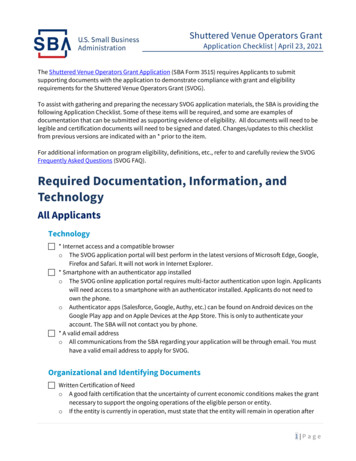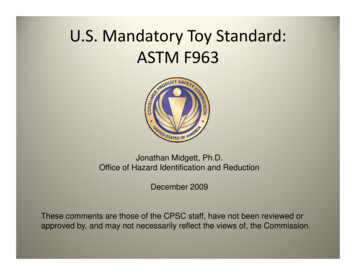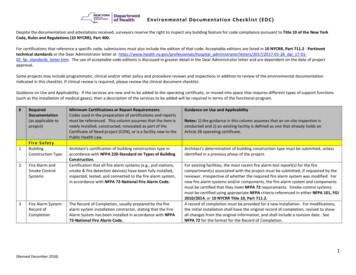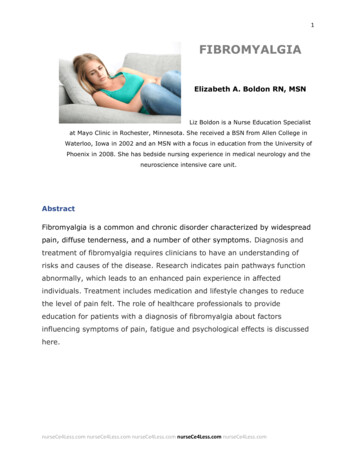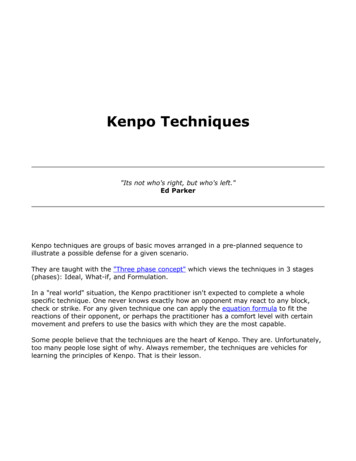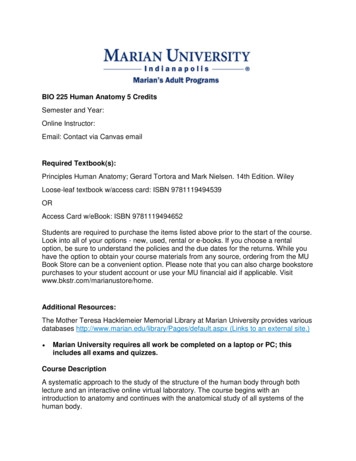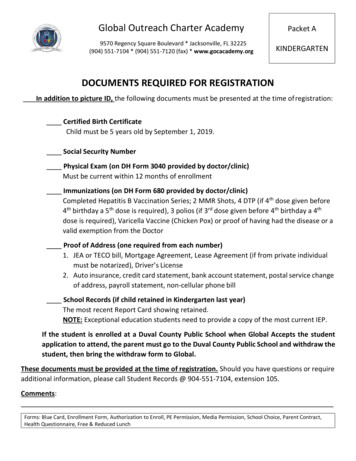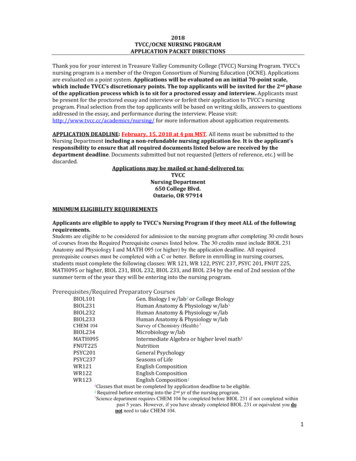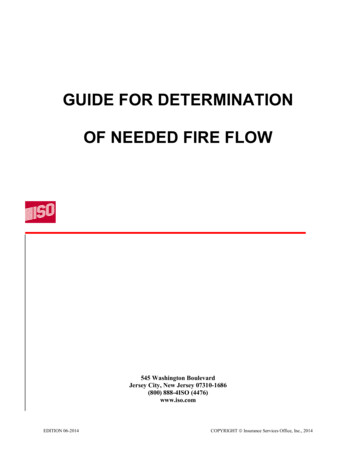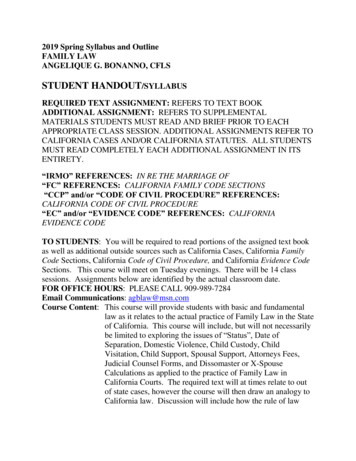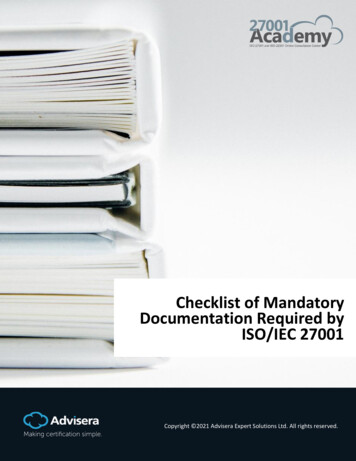
Transcription
Checklist of MandatoryDocumentation Required byISO/IEC 27001Copyright 2021 Advisera Expert Solutions Ltd. All rights reserved.Copyright 2021 Advisera Expert Solutions Ltd. All rights reserved.1
Table of Contents1. Which documents and records are required? . 32. Commonly used non-mandatory documents . 53. How to structure most common documents and records . 64. Sample documentation templates . 11Copyright 2021 Advisera Expert Solutions Ltd. All rights reserved.2
1. Which documents and records arerequired?The list below shows the minimum set of documents and records required by the ISO/IEC 27001 2013revision, which was reviewed and confirmed by ISO in 2019 and is currently valid standard:Documents*ISO 27001 clause numberScope of the ISMS4.3Information Security Policy and Objectives5.2, 6.2Risk Assessment and Risk Treatment Methodology6.1.2, 6.1.3Statement of Applicability6.1.3 d)Risk Treatment Plan6.1.3 e), 6.2, 8.3Risk Assessment and Risk Treatment Report8.2, 8.3Definition of Security Roles and ResponsibilitiesA.7.1.2, A.13.2.4Inventory of AssetsA.8.1.1Acceptable Use of AssetsA.8.1.3Access Control PolicyA.9.1.1Operating Procedures for IT ManagementA.12.1.1Secure System Engineering PrinciplesA.14.2.5Supplier Security PolicyA.15.1.1Incident Management ProcedureA.16.1.5Business Continuity ProceduresA.17.1.2Legal, Regulatory, and Contractual RequirementsA.18.1.1Copyright 2021 Advisera Expert Solutions Ltd. All rights reserved.3
Records*ISO 27001 clause numberRecords of training, skills, experience and qualifications7.2Monitoring and measurement results6.2, 9.1Internal audit program9.2Results of internal audits9.2Results of the management review9.3Results of corrective actions10.1Logs of user activities, exceptions, and security eventsA.12.4.1, A.12.4.3*Controls from Annex A can be excluded if an organization concludes there are no risks or otherrequirements which would demand the implementation of a control.This is by no means a definitive list of documents and records that can be used during the ISO 27001implementation – the standard allows any other documents to be added to improve the level ofinformation security.Copyright 2021 Advisera Expert Solutions Ltd. All rights reserved.4
2. Commonly used non-mandatorydocumentsOther documents that are very often used are the following:DocumentsISO 27001 clause numberProcedure for document control7.5Controls for managing records7.5Procedure for internal audit9.2Procedure for corrective action10.1Bring your own device (BYOD) policyA.6.2.1, A.6.2.2, A.13.2.1Mobile device and teleworking policyA.6.2.1, A.6.2.2, A.11.2.6Information classification policyA.8.2.1, A.8.2.2, A.8.2.3, A.8.3.1, A.8.3.3,A.9.4.1, A.13.2.3Password policyA.9.2.1, A.9.2.2, A.9.2.4, A.9.3.1, A.9.4.3Disposal and destruction policyA.8.3.2, A.11.2.7Procedures for working in secure areasA.11.1.5Clear desk and clear screen policyA.11.2.9Change management policyA.12.1.2, A.14.2.4Backup policyA.12.3.1Information transfer policyA.13.2.1, A.13.2.2, A.13.2.3Business impact analysisA.17.1.1Exercising and testing planA.17.1.3Maintenance and review planA.17.1.3Business continuity strategyA.17.1.1, A.17.2.1Copyright 2021 Advisera Expert Solutions Ltd. All rights reserved.5
3. How to structure most commondocuments and recordsScope of the ISMSThis document is usually rather short, and written at the beginning of the ISO 27001 implementation.Normally, it is a stand-alone document, although it can be merged into an Information security policy.Read more here: Problems with defining the scope in ISO 27001.Information security policy and objectivesInformation security policy is usually a short, top-level document describing the main purpose of the ISMS.Objectives for the ISMS are usually a stand-alone document, but they can also be merged into theInformation security policy. Unlike the ISO 27001 2005 revision, there is no more need for both ISMSPolicy and Information security policy – only one Information security policy is needed.Read more here: Information security policy – how detailed should it be?Risk assessment and risk treatment methodology & reportRisk assessment and treatment methodology is usually a document of 4 to 5 pages, and it should bewritten before the risk assessment and risk treatment are performed. The Risk assessment and treatmentreport has to be written after the risk assessment and risk treatment are performed, and it summarizesall the results.Read more here: ISO 27001 risk assessment & treatment – 6 basic steps.Statement of ApplicabilityThe Statement of Applicability (or SoA) is written based on the results of the risk treatment – this is acentral document within the ISMS because it describes not only which controls from Annex A areapplicable, but also how they will be implemented, and their current status. You could also consider theStatement of Applicability as a document that describes the security profile of your company.Read more here: The importance of Statement of Applicability for ISO 27001.Copyright 2021 Advisera Expert Solutions Ltd. All rights reserved.6
Risk treatment planThis is basically an action plan on how to implement various controls defined by the SoA – it is developedbased on the Statement of Applicability, and is actively used and updated throughout the whole ISMSimplementation. Sometimes it can be merged into the project plan.Read more here: Risk Treatment Plan and risk treatment process – What’s the difference?For more information, look at this short handbook: ISO 27001 Risk Management in Plain English.Security roles and responsibilitiesThe best method is to describe these throughout all policies and procedures, as precisely as possible.Avoid expressions like "should be done," and instead use something like "CISO will perform xyz everyMonday at zxy hours." Some companies prefer to describe security roles and responsibilities in their jobdescriptions; however, this may lead to lot of paperwork.Security roles and responsibilities for third parties are defined in contracts.Read more here: What is the job of Chief Information Security Officer (CISO) in ISO 27001?Inventory of assetsIf you didn't have such an inventory prior to the ISO 27001 project, the best way to create such adocument is directly from the result of the risk assessment – during the risk assessment all the assets andtheir owners must be identified anyway, so you just copy the results from there.Read more here: How to handle Asset register (Asset inventory) according to ISO 27001.Acceptable use of assetsThis is usually written in the form of a policy, and such a document can cover a very wide range of topicsbecause the standard doesn't define this control very well. Probably the best way to approach it is thefollowing: (1) leave it for the end of your ISMS implementation, and (2) all the areas & controls that youhaven't covered with other documents and that concern all employees, cover them with this policy.Copyright 2021 Advisera Expert Solutions Ltd. All rights reserved.7
Access control policyIn this document, you can cover only the business side of approving access to certain information andsystems, or also the technical side of access control; further, you can choose to define rules for only logicalaccess, or also for the physical access. You should write this document only after you finish your riskassessment and risk treatment process.Operating procedures for IT managementYou can write this as a single document, or as a series of policies and procedures – if you are a smallercompany, you will tend to have a smaller number of documents. Normally, you can cover all the areasfrom sections A.12 and A.13 – change management, third-party services, backup, network security,malicious code, disposal and destruction, information transfer, system monitoring, etc. You should writethis document only after you finish your risk assessment and risk treatment process.Read more about IT management here: ITIL & ISO 20000 Blog.Secure system engineering principlesThis is a new control in ISO 27001, and requires that secure engineering principles be documented in theform of a procedure or standard, and should define how to incorporate security techniques in allarchitecture layers – business, data, applications and technology. These can include input data validation,debugging, techniques for authentication, secure session controls, etc.Supplier security policyThis is also a new control in ISO 27001, and such policy can cover a wide range of controls – how thescreening of potential contractors is done, how the risk assessment of a supplier is made, which securityclauses to insert into the contract, how to supervise the fulfilment of contractual security clauses, how tochange the contract, how to close the access once the contract is terminated, etc.Read more here: 6-step process for handling supplier security according to ISO 27001.Incident management procedureThis is an important procedure which defines how the security weaknesses, events and incidents arereported, classified and handled. This procedure also defines how to learn from information securityincidents, so that they can be prevented the next time. Such a procedure can also invoke the Businesscontinuity plan if an incident has caused a lengthy disruption.Copyright 2021 Advisera Expert Solutions Ltd. All rights reserved.8
Business continuity proceduresThese are usually business continuity plans, incident response plans, recovery plans for business side ofthe organization, and disaster recovery plans (recovery plans for IT infrastructure). These are the bestdescribed in the ISO 22301 standard, the leading international standard for business continuity.To learn more, click here: Business continuity plan: How to structure it according to ISO 22301.Legal, regulatory, and contractual requirementsThis list should be made as early in the project as possible, because many documents will have to bedeveloped according to these inputs. This list should include not only responsibilities for complying withcertain requirements, but also the deadlines.Records of training, skills, experience and qualificationsThese records are normally maintained by the human resources department – if you don't have such adepartment, anyone who usually maintains the employee's records should be doing this job. Basically, afolder with all the documents inserted in it will do.Read more here: How to perform training & awareness for ISO 27001 and ISO 22301.Monitoring and measurement resultsThe easiest way to describe the way controls are to be measured is through policies and procedures whichdefine each control – normally, this description can be written at the end of each document, and suchdescription defines the kinds of KPIs (key performance indicators) that need to be measured for eachcontrol or group of controls.Once this measurement method is in place, you have to perform the measurement accordingly. It isimportant to report these results regularly to the persons who are in charge of evaluating them.Read more here: ISO 27001 control objectives – Why are they important?Internal audit programThe Internal audit program is nothing else but a 1-year plan for performing the audits – for a smallercompany this could be only one audit, whereas for a larger organization this could be a series of, e.g., 20internal audits. This program should define who would perform the audits, methods, audit criteria, etc.Read more here: How to make an Internal Audit checklist for ISO 27001 / ISO 22301.Copyright 2021 Advisera Expert Solutions Ltd. All rights reserved.9
Results of internal auditsAn internal auditor must produce the Audit report, which includes the audit findings (observations andcorrective actions). Such report must be produced within a couple of days after an internal audit isperformed. In some cases, the internal auditor will have to check whether all the corrective actions havebeen performed as expected.Results of the management reviewThese records are normally in the form of meeting minutes – they have to include all the materials thatwere involved at the management meeting, as well as all the decisions that were made. The minutes canbe in paper or digital form.Read more here: Why is management review important for ISO 27001 and ISO 22301?Results of corrective actionsThese are traditionally included in Corrective action forms (CARs). However, it is much better to includesuch records in some application that is already used in an organization for Help Desk – because correctiveactions are nothing but to-do lists with clearly defined responsibilities, tasks and deadlines.Read more here: Practical use of corrective actions for ISO 27001 and ISO 22301.Logs of user activities, exceptions, and security eventsThese are normally kept in two forms: (1) in digital form, automatically or semi-automatically producedas logs of various IT and other systems, and (2) in paper form, where every record is written manually.Procedure for document controlThis is normally a stand-alone procedure, 2 or 3 pages long. If you already implemented some otherstandard like ISO 9001, ISO 14001, ISO 22301 or similar, you can use the same procedure for all thesemanagement systems. Sometimes it is best to write this procedure as the first document in a project.Read more here: Document management in ISO 27001 & BS 25999-2.You can use this free ISO online tool for handling your documentation, i.e., using it as a documentmanagement system (DMS).Copyright 2021 Advisera Expert Solutions Ltd. All rights reserved.10
Controls for managing recordsThe easiest way is to describ
The list below shows the minimum set of documents and records required by the ISO/IEC 27001 2013 revision, which was reviewed and confirmed by ISO in 2019 and is currently valid standard: Documents* ISO 27001 clause number Scope of the ISMS 4.3 Information Security Policy and Objectives 5.2, 6.2
